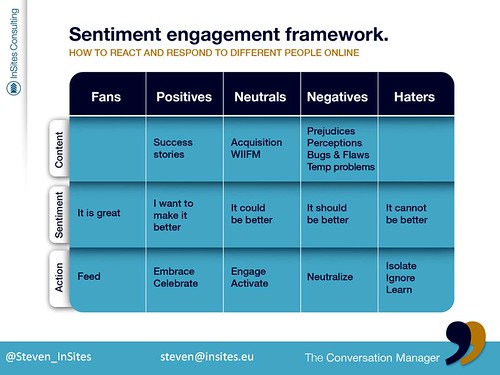How do you manage online conversations for haters vs. lovers of your brand?


5 types of emotions all need a different conversation approach
Not all consumers have the same relation with your brands. Each individual’s context determines how they see your brand. Sentiments can be much diversified. It is very useful to determine beforehand what your approach of different sentiments will be. Online conversations originate from different types of people. Some are real fans of your brand and others may hate it. In-between there are some 3 different levels, going from positive over neutral to negative. Each of these sentiments needs a different reaction by your brand.
- Fans: they think that everything your brand does is brilliant. You will never hear a negative word from them and everything you say will be repeated by them to others with great pleasure. The only thing you need to do is to provide them with sufficient content to share. In other words, a proactive content strategy is key. If you give them nothing, you miss their possible impact on your company.
- Positives: this is probably the most interesting group, according to me. They are very positive towards the outside world. They share success stories with others. However, this group would love to help to improve your brand. They often try to help behind the scenes and to give feedback. The art is to involve them in the development of new products or new communications for your brand. They are keen to contribute; they have a healthy critical mind and understand clearly what your brand is aiming for.
- Neutrals: they are not bothered by your brand. In order to activate these people you need to create a clear advantage for them. These are typically the people who will be activated by a ‘re-tweet’ action where they can win a prize. Content with a clear direct benefit is the key to activation.
- Negatives: they will often spread negative messages about your brands. They are really convinced things should be improved (vs. positives who think it COULD be done better). The art is to neutralise them. Make sure that their negative comments are dealt with in a positive, empathic way. That is how they lose their impact.
- Haters: they have lost all faith in your brand. They are convinced your company simply hasn’t got what it takes. Everything you may say or do will be misunderstood and misinterpreted by them. They abhor the idea that they may have something to do with your products. This group needs to be isolated and ignored. Everything we may say to them will add fuel to the flames. It would be interesting to find out (via observation) what causes these extreme feelings. We could learn from the past in order to avoid that other people start feeling that way about us.
There is need for a reactive as well as a proactive conversation strategy
When developing a conversation strategy it is important to take all these profiles into account. The classic mistake consists in focusing primarily on the negative conversations. Quite a few companies make huge investments in web care to arm themselves against the spreading of negative consumer feedback. This is great, of course, but this should be a balanced effort.
Positive people and fans deserve at least as much attention. However, it takes a bigger effort for a company to be able to benefit from the good intentions of this particular group of people. Webcare is a reactive strategy: you wait for questions or complaints and gear your organisation to answering them as quickly as possible. Activating positive people requires a proactive content strategy where you are the one developing content for them to pass on. This means involving them in the creation of new products or new content. Both aspects of conversation management are important.
Planting many seeds and putting out many fires
The philosophy behind this approach is to plant many seeds and to put out many fires. If you provide positive people with subjects to talk about and you involve them in your company in a relevant and proactive way, this will generate many a positive conversation. These will eventually lead to opportunities for your company. Dealing with the negatives’ comments in an empathic and positive way will stop the negative conversations from the start.
